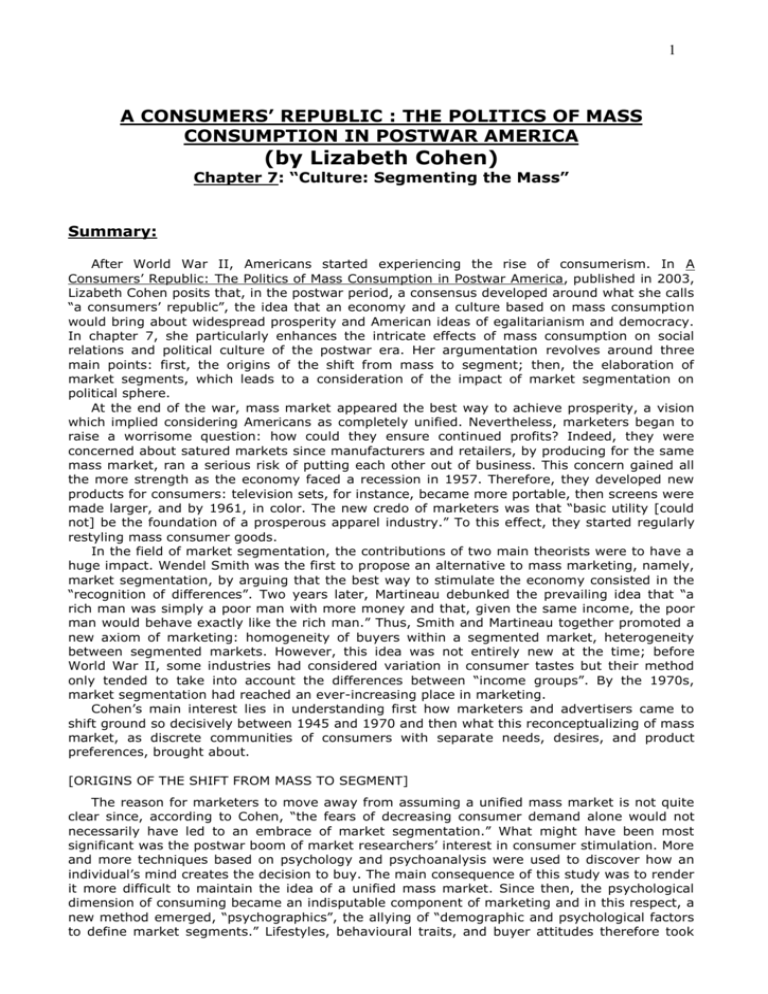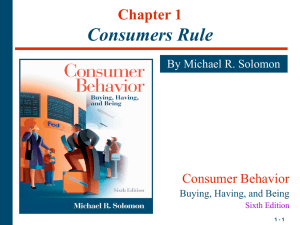A CONSUMERS' REPUBLIC : THE POLITICS OF MASS
advertisement

1 A CONSUMERS’ REPUBLIC : THE POLITICS OF MASS CONSUMPTION IN POSTWAR AMERICA (by Lizabeth Cohen) Chapter 7: “Culture: Segmenting the Mass” Summary: After World War II, Americans started experiencing the rise of consumerism. In A Consumers’ Republic: The Politics of Mass Consumption in Postwar America, published in 2003, Lizabeth Cohen posits that, in the postwar period, a consensus developed around what she calls “a consumers’ republic”, the idea that an economy and a culture based on mass consumption would bring about widespread prosperity and American ideas of egalitarianism and democracy. In chapter 7, she particularly enhances the intricate effects of mass consumption on social relations and political culture of the postwar era. Her argumentation revolves around three main points: first, the origins of the shift from mass to segment; then, the elaboration of market segments, which leads to a consideration of the impact of market segmentation on political sphere. At the end of the war, mass market appeared the best way to achieve prosperity, a vision which implied considering Americans as completely unified. Nevertheless, marketers began to raise a worrisome question: how could they ensure continued profits? Indeed, they were concerned about satured markets since manufacturers and retailers, by producing for the same mass market, ran a serious risk of putting each other out of business. This concern gained all the more strength as the economy faced a recession in 1957. Therefore, they developed new products for consumers: television sets, for instance, became more portable, then screens were made larger, and by 1961, in color. The new credo of marketers was that “basic utility [could not] be the foundation of a prosperous apparel industry.” To this effect, they started regularly restyling mass consumer goods. In the field of market segmentation, the contributions of two main theorists were to have a huge impact. Wendel Smith was the first to propose an alternative to mass marketing, namely, market segmentation, by arguing that the best way to stimulate the economy consisted in the “recognition of differences”. Two years later, Martineau debunked the prevailing idea that “a rich man was simply a poor man with more money and that, given the same income, the poor man would behave exactly like the rich man.” Thus, Smith and Martineau together promoted a new axiom of marketing: homogeneity of buyers within a segmented market, heterogeneity between segmented markets. However, this idea was not entirely new at the time; before World War II, some industries had considered variation in consumer tastes but their method only tended to take into account the differences between “income groups”. By the 1970s, market segmentation had reached an ever-increasing place in marketing. Cohen’s main interest lies in understanding first how marketers and advertisers came to shift ground so decisively between 1945 and 1970 and then what this reconceptualizing of mass market, as discrete communities of consumers with separate needs, desires, and product preferences, brought about. [ORIGINS OF THE SHIFT FROM MASS TO SEGMENT] The reason for marketers to move away from assuming a unified mass market is not quite clear since, according to Cohen, “the fears of decreasing consumer demand alone would not necessarily have led to an embrace of market segmentation.” What might have been most significant was the postwar boom of market researchers’ interest in consumer stimulation. More and more techniques based on psychology and psychoanalysis were used to discover how an individual’s mind creates the decision to buy. The main consequence of this study was to render it more difficult to maintain the idea of a unified mass market. Since then, the psychological dimension of consuming became an indisputable component of marketing and in this respect, a new method emerged, “psychographics”, the allying of “demographic and psychological factors to define market segments.” Lifestyles, behavioural traits, and buyer attitudes therefore took 2 up an increasing place in consumer profiles. By 1985, this method allowed marketers to boast their new aptitude to know their marketing target even better than the buyers themselves, who thus became an easy prey. Another discipline, sociology, was introduced in the world of marketing, and its combination with the use of computers, enabled marketers to define more precisely “the match between product and segment”. The use of social sciences in marketing paved the way for market segmentation and gave marketers the capacity to identify and cater to specific segments of consumers. The development of television as a new frontier for advertising helped foster a receptive climate to market segmentation. Indeed, it targeted programs at demographically specific audiences. For instance, children in the early morning and homemakers during the day, thus commercials could be specifically adapted to relevant viewers. Market segmentation was stimulated further when the struggle over who would actually produce television programs resulted in the defeat of advertising agencies. From then on, networks took control over program creation, and encouraged shows to have multiple sponsors. The breaking of the once exclusive link between a sponsor and its own show, it brought in more “advertising dollars” from sources singled out for specialized consumers at different times on different stations. Segmentation of the television market was thus greatly intensified. The emergence of cable television in metropolitan markets in the 1970s, by bringing a wide range of viewers options only amplified “the carving up of television programming and audiences into market niches” and generated a whole new dimension for market segmentation. Ironically, market segmentation had only been possible because the industrial production process had become more flexible, encouraging mass production to develop on the basis of lowering production costs by producing standardized products for a wide range of customers. Despite the main criticism of the fifties that the standardization associated with mass consumption shaped social conformity and homogeneity, advertising agencies was moving towards the opposite direction, as they acknowledged social differences by embracing market segmentation. They no longer regarded the market as unified and homogeneous but as segmented into communities of consumers, with distinctive traits, thus shifting their attention from product to user. And this the reason why Cohen posits in this chapter that “segmenting the mass market helped democratize it, allowing subcultures to shape markets around their own priorities.” [THE ELABORATION OF MARKET SEGMENTS] Market segmentation had a major impact, insomuch as it lent support and recognition to social and cultural differences among Americans, acknowledging “countercultures”. Indeed individuals were given the possibility to voice their distinct identities through their choices as consumers. By the 1960s with the shift to market segmentation, marketers had turned class differentiation from an income criterion towards that of lifestyle. During the 1950s and 1960s, Americans’ standard of living was steadily increasing, marketers began to focus on the working class that represented a interesting market. By the 1980s, they had shifted their attention to upper-class consumers that had more money to spend. Segmentation by gender, a profitable step in marketing, was undertaken. In the beginning, marketers had envisioned consumers as female; in the 1920s and 1930s, women were viewed as “purchasing agents” for their families. World War II only intensified the authority of female consumers on the home front. But in the postwar era, the rise of consumerism encouraged marketers to shift their attention to the “family unit” as men acquired more influence over consumption, going shopping with their wives. Gender segmentation reached a further level when men and women were increasingly viewed as distinctive, lucrative market segments with different desires and responsibilities. Paradoxically enough, little was know about the specific nature of male buyers and it was only in the 1980s that men came in for serious interest and research. Products too were categorized by who had primary responsibility for their purchase, with advertising campaigns tailored for specific audiences: on the one hand, ads to sell automobiles or cigarettes were designed to men; on the other hand, to sell cosmetics, or laundry detergent, ads, were aimed at women. Gender segmentation thoroughly exemplified the idea that segmenting the market not only differentiated the basic categories of female and male, but also subdivided them into smaller groups. By the mid-1980s the subdivision of the female market by social class assumed the lifestyle emphasis invading class differentiation. Another illustration of how subcultural protest could spawn new strategies of market segmentation is the example of feminism in the 1960s and 1970s, challenging traditional female roles and gender bias in the media. Marketers make good use of it, by creating a new 3 feminist market segment. In doing so, they accomplished two goals: first, this open-minded attitude towards women provided a greater measure of fair treatment for women; secondly, it was an intelligent marketing decision. Two other sorts of market segmentation – by age and by race or ethnicity- flourished. Indeed, some members of the family, besides the mother, gained personal purchasing power, transforming the postwar family in a collection of variously aged individuals with specific consumer desires: Teenagers: The teen market was discovered before the emergence of market segmentation since promoters begun using this idea in the 1940s. Cohen underlines the ever-growing place teenagers have taken until now, generating a wide industry relying solely on them. Children: They reached a more powerful position as consumers for, thanks to television, it is possible to appeal to them independently of their parents. Until the mid-1950s, the promotion of toys and games was limited and what existed was directed mostly at parents. Ads boldly displayed on television screens made it easy for the non-reader to identify a toy on a supermarket shelf. For the sake of consumption, marketers viewed children as future consumer adults, and thus paved the way for “their voyage from child to teen to adult male or female segment”. To this effect, for instance, Mattel’s teenage Barbie with her closet full of fashionable outfits and accessories taught the importance and even the necessity of how you dressed and what you owned. Seniors: By the late 1960s, “seniors” had become a new marketing segment, well worth catering to. Blacks: Sometimes products such as a black Barbie doll were made specifically for black buyers. More often, items were mass-marketed goods, but the ads were carefully tailored to attract African-American consumers. This did not establish another level of segregation but, on the contrary, lent Blacks recognition. This shift in marketing attitude accompanied the larger evolution of civil rights. Yet it had a quite negative impact on the economics of AfricanAmerican communities: indeed, the more white manufacturers fulfilled black demands for recognition, the more it contributed to the demise of separate black business districts. Ethnic population: by the 1970s, marketer segmenters had begun being interested in other ethnic population. First, the Latinos have been “the most recent high-stakes” market for segmenters due to an ongoing immigration and a high birth rate. On the other hand, the “Asian-American market”, despite its smaller size, generates great hopes for marketers as they expand quickly and tend to earn more money. The gay market was targeted as well but in a more discrete and ambiguous way. Ads avoided explicit references to homosexuality but sends distinct signals to gay males and lesbians. The author concludes on the impact segment marketing has had over the years: firstly, it acknowledged and reinforced subcultural identities, thus providing rather powerless Americans, such as workers, African-Americans, Latinos, a kind of legitimacy through proving their worth in the consumer place. Yet, it laid the ground for a more fragmented America, in which the marketplace became more like other fractured places in the postwar America. [SEGMENTING VOTERS IN POLITICAL MARKETS] In the very last part of the chapter, Cohen’s focus turns to the consideration of the impact of market segmentation on politics. Indeed, mass marketing became increasingly interwoven with other aspects of life, especially politics, thus bringing to light a possible connection between market structure and political structure. This remained a hypothesis since the 1940s; yet, as Americans became more and more “consumers of politics”, they responded to the packaging of leaders or events as they did to products, confirming what was first an assumption. In this respect, Vance Packard voiced a legitimate fear in his sharp diatribe against advertisers and marketers, The Hidden Persuaders. He was afraid of what he saw as a threat to American democracy: the idea that voters would choose their leaders not on their programs but on the emotional response their ads campaigns would bring about. The application of mass marketing techniques to the political sphere dates back the turn of the century; however, it reached a further lever of intensity in the 1960s, when consumer research developed public opinion polling, which definitively changed American politics. Surprisingly enough, the “grandfatherly” Eisenhower was the first candidate in 1952, and again in 1956, to bring mass marketing into the political field. At these occasions, the Republican Party hired three major New York advertising agencies, thereby developing the strategy of buying time at the end of top-rated programs to capture those who were already tuned-in and initiating a new form of appealing spot. The adaptation of market segmentation to 4 the political sphere evolved later in the 1960s: the new strategy encouraged crafting special messages for distinctive segments about which more and more was becoming known thanks to the increasingly sophisticated polling. The change was first visible during the 1960 presidential campaign that opposed Kennedy and Nixon. This election is worth mentioning insomuch as it reveals Kennedy’s new attention to voter segments. Indeed, far from appealing exclusively to the mass of Americans as Eisenhower had done, he tailored his messages to his audiences. Another step that has been taken in the political field is the development of direct mail strategy that “made targeting audiences with particular messages much more precise than was possible with television advertising and other traditional media.” Nevertheless, Cohen points out a major danger that the ever-growing influence of market segmentation on the “political arena” has brought about, that of a perpetual dependence on pollsters. Then, she concludes on two aspects of the new political era that has been initiated : first, the strong enhancement of the American democracy, since candidates no longer ignore the identity and needs of voters; but this sharply counterpoints with a stronger drawback, the necessity to possess a great amount of money to be elected. Commentary: In my opinion, there are not many elements to criticize in this text –if there is one at all. Cohen manages perfectly well to take the reader for a ride into the advertising world and underscores nonetheless the great implications it had on the political sphere, implications that may be seen still today in an even magnified way. As far as I can tell, she perfectly follows the line of thought she announced in the introduction, and makes a no less perfect statement about the early link between marketing and politics, which I happened to find extremely interesting and enlightening. Moreover, she voices her ideas in a simple way so that it is easy to understand the intricate effects of the shift from mass market to segment market. She also summarizes her points quite often throughout the chapter, making her argumentation always clearer. Illustrating the text by cartoons or pictures is a rather good strategy because they completely convey her argumentation and give the reader a more precise and concrete testimony of the huge change that took place in advertising at the time. The examples she chose are obviously quite relevant for they usually refer to familiar brands or contexts. Yet to make a small criticism, I would have liked to read at least one concrete case of what changed for the seniors, in terms of ads, when they became a market segment. Indeed, Cohen tells us several times that marketers realized that it was an important and even essential part of the market but she never gives us an example as she does for Blacks or teenagers.








